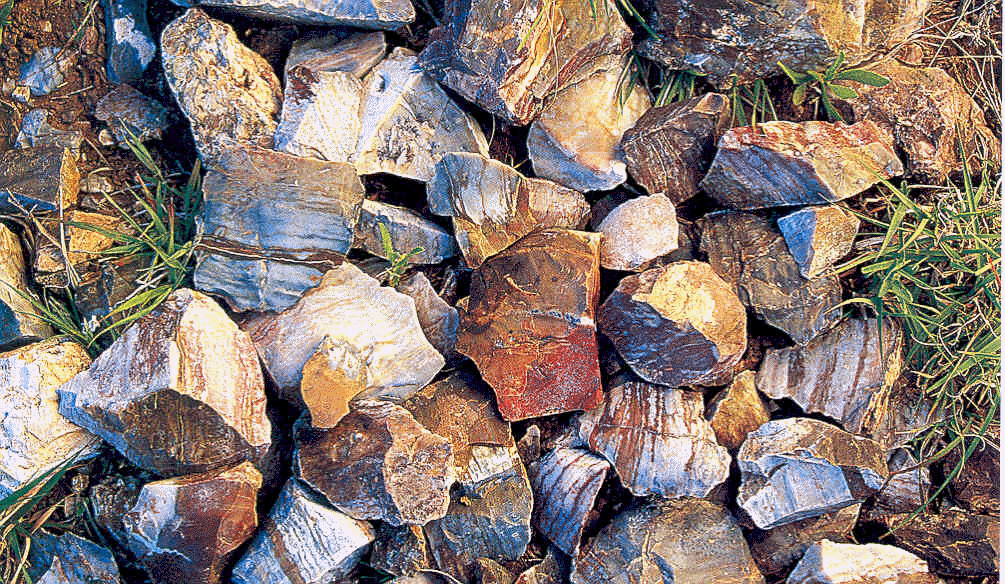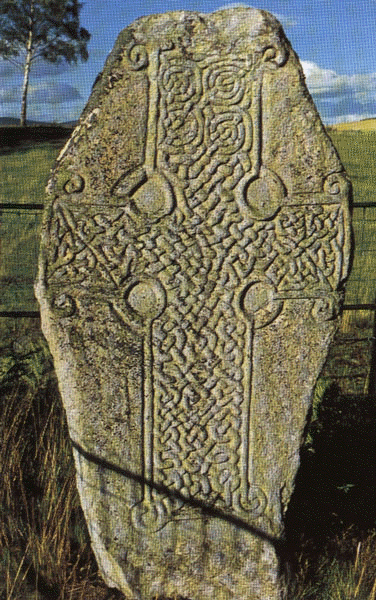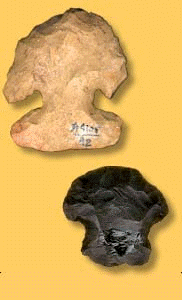HOME
ELEMENTS
Flint
 Flint
was widely used by early humans. The stone is relatively common and
produces sharp edges when fractured, making it ideal for tools and
weapons. The adzes (shown left and middle) were used for shaping wood
and the sickle (shown right) was used in harvesting during the late
Stone Age. Note: The wooden handles are reproductions. Encarta
Encyclopedia Dorling Kindersley
Flint
was widely used by early humans. The stone is relatively common and
produces sharp edges when fractured, making it ideal for tools and
weapons. The adzes (shown left and middle) were used for shaping wood
and the sickle (shown right) was used in harvesting during the late
Stone Age. Note: The wooden handles are reproductions. Encarta
Encyclopedia Dorling Kindersley
Flint is a common variety of
quartz, with a dull, usually dark color, often found as nodules  in
chalk deposits. Highest quality flint is from the coastal chalk
deposits of Great Britain and northern France, and poorer grades
occur in the Cretaceous limestones of the United States and various
other parts of the world.
in
chalk deposits. Highest quality flint is from the coastal chalk
deposits of Great Britain and northern France, and poorer grades
occur in the Cretaceous limestones of the United States and various
other parts of the world.
Flint is a hydrated
silica that, under certain conditions, appears to lose water at its
surface leaving a thin, porous coating, or patina, of white silica.
On the new surfaces of freshly fractured fragments, the flint has a
waxy luster.
Flint breaks with a
conspicuous conchoidal fracture, producing sharp edges. Prehistoric
peoples found fragments of flint useful for sharp weapons and cutting
instruments such as axheads, arrowheads, and knives. When flint is
struck with  steel,
sparks are readily produced; it was therefore extensively used in
the past for igniting tinder and for firing gunpowder in flintlock arms.
steel,
sparks are readily produced; it was therefore extensively used in
the past for igniting tinder and for firing gunpowder in flintlock arms.
Flint is principally used
today as an ingredient of fine pottery. “Flints” used in
cigarette lighters are an alloy of rare earth metals and iron and
have no relation to the quartz flint.

 Sometime
after people began to use stone for tools, they found that by
rubbing together pieces of flint they could produce sparks that would
set fire to wood shavings. Scientists have found evidence that people
used pieces of flint and iron to produce sparks for fires 25,000 to
35,000 years ago.
Sometime
after people began to use stone for tools, they found that by
rubbing together pieces of flint they could produce sparks that would
set fire to wood shavings. Scientists have found evidence that people
used pieces of flint and iron to produce sparks for fires 25,000 to
35,000 years ago.
The cryptocrystalline
varieties of quartz are often divided into two general classes,
fibrous and granular. The fibrous varieties, which include agate,
carnelian, heliotrope, onyx, and chrysoprase, are all forms of
chalcedony. The granular varieties include chert, flint, jasper, and prase.
http://www.ele.net/folsom.htm
http://www.oplin.lib.oh.us/products/flint/index.html
Microsoft ® Encarta ®
Encyclopedia 2002. © 1993-2001 Microsoft Corporation. All rights reserved.
 Flint
was widely used by early humans. The stone is relatively common and
produces sharp edges when fractured, making it ideal for tools and
weapons. The adzes (shown left and middle) were used for shaping wood
and the sickle (shown right) was used in harvesting during the late
Stone Age. Note: The wooden handles are reproductions. Encarta
Encyclopedia Dorling Kindersley
Flint
was widely used by early humans. The stone is relatively common and
produces sharp edges when fractured, making it ideal for tools and
weapons. The adzes (shown left and middle) were used for shaping wood
and the sickle (shown right) was used in harvesting during the late
Stone Age. Note: The wooden handles are reproductions. Encarta
Encyclopedia Dorling Kindersley in
chalk deposits. Highest quality flint is from the coastal chalk
deposits of Great Britain and northern France, and poorer grades
occur in the Cretaceous limestones of the United States and various
other parts of the world.
in
chalk deposits. Highest quality flint is from the coastal chalk
deposits of Great Britain and northern France, and poorer grades
occur in the Cretaceous limestones of the United States and various
other parts of the world. steel,
sparks are readily produced; it was therefore extensively used in
the past for igniting tinder and for firing gunpowder in flintlock arms.
steel,
sparks are readily produced; it was therefore extensively used in
the past for igniting tinder and for firing gunpowder in flintlock arms.
 Sometime
after people began to use stone for tools, they found that by
rubbing together pieces of flint they could produce sparks that would
set fire to wood shavings. Scientists have found evidence that people
used pieces of flint and iron to produce sparks for fires 25,000 to
35,000 years ago.
Sometime
after people began to use stone for tools, they found that by
rubbing together pieces of flint they could produce sparks that would
set fire to wood shavings. Scientists have found evidence that people
used pieces of flint and iron to produce sparks for fires 25,000 to
35,000 years ago.